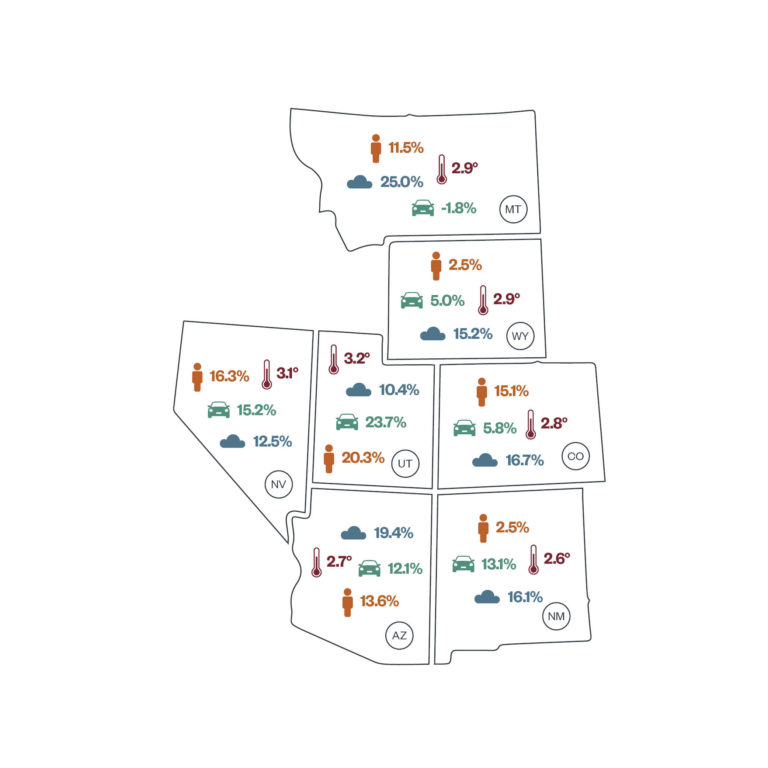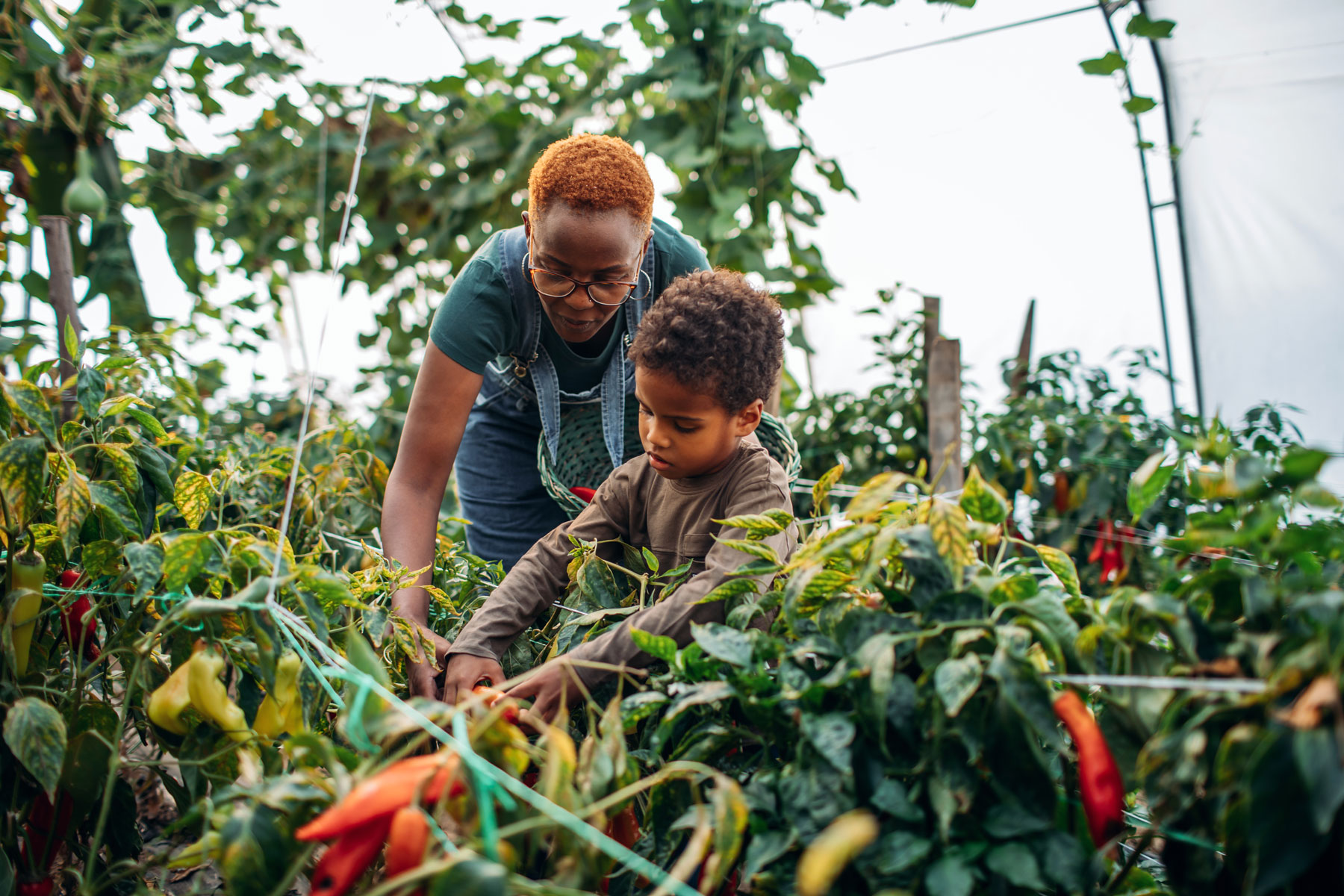The reality of climate change is no longer a worry of the future. The impacts are here now, and communities in the Interior West are facing increasingly harsh conditions as a result.
While each community is unique in terms of its strengths and vulnerabilities to climate-related impacts, the West is especially vulnerable, and we are already living with an ongoing megadrought, catastrophic wildfires, dangerous heat waves, and worsening air pollution.
But it doesn’t have to be this way. There is hope and healing in building community resilience to climate change.
Resilience is the capacity to recover – to bounce back – from difficulties. It is the ability of a community, business, or natural environment to prevent, withstand, respond to, and recover from disruptions linked to extreme weather conditions or climate-related hazards.
Reducing the impacts of these hazards on the lives and livelihoods of residents of the West is a top priority for WRA. We work to anticipate climate impacts, assess vulnerabilities, develop climate solutions, and implement them. We know that we need proactive and robust actions – so our communities are better prepared to respond today and tomorrow.
Taking Action Today
When most people think of climate change in the West, drought and water scarcity are likely the first things that come to mind. The Colorado River is at its lowest levels in modern history, and its two biggest reservoirs, Lake Powell and Lake Mead, are at some of their lowest points since construction – and they continue to decline. This is a critical system that supplies water for more than 40 million people living across seven Western states and Mexico.
WRA works with communities on land use codes, zoning ordinances, conservation programs, and conservation tools to more efficiently manage and use our water resources. For example, WRA led in developing and advocating for a turf replacement bill in Colorado. It requires the state to provide financial resources to property owners to remove water-intensive turf grass and replace it with more water-efficient landscaping. Programs like this help to ensure communities can respond and adapt to the future of increasing climate change impacts and even less water availability.
Underlying water scarcity is significant population growth. The West has some of the fastest growing populations in the country. The combination of more people and less water puts massive strain on the Colorado River, and that makes protecting our precious resources even more critical. Beyond protecting what we have, we also must consider how a dwindling water supply will be equitably allocated. WRA is working with state and federal decision makers, Indigenous nations, water users, and key stakeholders across the region to redesign a robust and resilient river management agreement that can work for the entire river basin.
This continued aridification, or drying out, of the region is also escalating fire behavior, transforming wildfire that has been a natural part of the landscape for millennia into catastrophic megafire events that have become a year-round threat for towns and cities across the West.
At WRA, we are leveraging our expertise in state-level policy development to identify opportunities that would give communities more tools and funding to bolster resilience to wildfire, while achieving co-benefits for landscape and habitat conservation. One solution is to increase the use of prescribed burns – controlled fires conducted under the trained and watchful eye of experts – as a safe mitigation tool. Healthy forests treated with prescribed burns can lead to improved air quality, protecting our communities and encouraging ecosystem health.
Another approach is through better land use planning, especially in high fire-risk areas, and identifying state-level policies that could be improved or strengthened to help local governments thoughtfully plan for growth to avoid putting future communities in harm’s way. With more people moving into high fire-risk areas, it is increasingly difficult to use tools like prescribed burning to reduce the risk of catastrophic fire. That forces the continued use of aggressive fire suppression strategies to protect communities. To break this vicious cycle, we need to think differently about where and how we develop communities and what tools we need to reduce the risks to them.
This strategic approach to development includes a careful and calculated look at our energy use and sources. The burning of fossil fuels is driving the climate crisis, so in order to address this, we need to rapidly transition away from their use.
But as temperatures continue to increase, so does our use of fossil fuels for air conditioning, as an example. In Colorado, Utah, and Wyoming, air conditioning use in the population jumped from about 60% in 2009 to around 80% in 2020. WRA not only is working to clean up the electric grid, replacing coal and gas generation with renewables. We are simultaneously improving grid flexibility to handle more peak demand as the days get hotter and more people use air conditioning.
Fossil fuel use in buildings also has public health implications. Burning gas in buildings, particularly for cooking, causes nitrogen oxide emissions that can create respiratory issues and are linked to childhood asthma. WRA was instrumental in passing a clean heat standard in Colorado last year, which will require gas utilities in the state to reduce their emissions from both their distribution system and end use gas consumption in buildings.
Another fundamental transition that WRA is spearheading in our region is transportation electrification, including the implementation of Advanced Clean Cars II and Advanced Clean Trucks regulations in Colorado, Nevada, and New Mexico. Fossil-fueled vehicles contribute to climate change and air pollution that disproportionately impacts low-income communities located along highways and near industrial areas. We are working to transition personal cars, commercial fleets, and public transit, like buses and trains, from fossil-fueled vehicles to those powered by electricity. Electric vehicles emit two to five times less greenhouse gas pollution than fossil-fueled vehicles, depending on the source of the electricity. The transition to electric vehicles provides substantial economic, environmental, and public health benefits, and the faster the transition occurs, the faster those benefits are realized by our communities.
But while the transition to clean energy will reduce the use of fossil fuels for energy, increase renewable energy sources, and create energy resilience, fossil fuel extraction industries have been major economic engines for many communities around the West. As coal power plants and mines close, it is critical to support those who relied on them. WRA is working in several states to help make sure these transitions away from fossil fuel energy are happening in a just and equitable way.
WRA has been fully engaged in the coal transition in Arizona, working with the Arizona Corporation Commission to address funding, repurposing of plants and facilities, and benefits and impacts to ratepayers. Several Indigenous communities and their tribal government budgets substantially depend on the money generated from these power plants and coal mines. We are committed to advancing a fair and equitable transition from coal power to clean energy sources to avoid detrimental economic and human impacts. For example, WRA advocates for the siting of new clean energy power plants in proximity to switch yards and transmission lines already in place from shuttered coal plants, creating new jobs and continuing and often increasing tax revenue in these communities.
Building for Tomorrow
WRA is working with decision makers to find creative ways to prepare for future climate challenges. Through our state-level on-the-ground work, we are developing and supporting programs and policies that are effective and equitable for the needs of our communities.
Once we start down the path of building resilience, the positive effects become synergetic – centering on more efficient water use, building and transportation electrification, and smart land use and development, all while advancing a just and equitable transition.
Resilience offers us opportunities to prepare for new climate conditions, reduce greenhouse gas emissions, and address issues of environmental injustices. Together, we can slow the impacts of climate change, while creating more livable, healthy ecosystems and thriving communities throughout the West.
Making Progress Toward Climate Resilience
As the population in the West continues to grow and temperatures are on the rise, climate resilience means taking steps to drastically decrease our water usage from the Colorado River, reduce our region’s dependence on fossil fuels, and catalyze the transition to electric vehicles.








